Related Research Articles
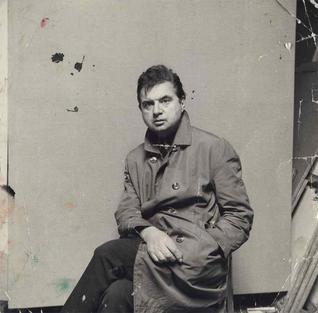
Francis Bacon was an Irish-born British figurative painter known for his raw, unsettling imagery. Focusing on the human form, his subjects included crucifixions, portraits of popes, self-portraits, and portraits of close friends, with abstracted figures sometimes isolated in geometrical structures.

Lucian Michael Freud was a British painter and draughtsman, specialising in figurative art, and is known as one of the foremost 20th-century English portraitists. He was born in Berlin, the son of Jewish architect Ernst L. Freud and the grandson of Sigmund Freud. Freud got his first name "Lucian" from his mother in memory of the ancient writer Lucian of Samosata. His family moved to England in 1933, when he was 10 years old, to escape the rise of Nazism. He became a British naturalized citizen in 1939. From 1942 to 1943 he attended Goldsmiths' College, London. He served at sea with the British Merchant Navy during the Second World War.
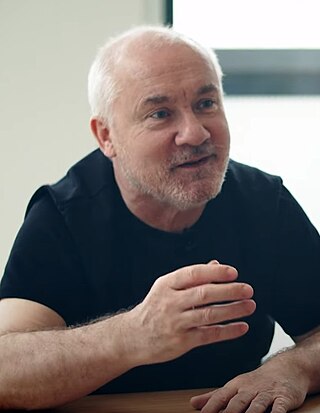
Damien Steven Hirst is an English artist and art collector. He is one of the Young British Artists (YBAs) who dominated the art scene in the UK during the 1990s. He is reportedly the United Kingdom's richest living artist, with his wealth estimated at US$384 million in the 2020 Sunday Times Rich List. During the 1990s his career was closely linked with the collector Charles Saatchi, but increasing frictions came to a head in 2003 and the relationship ended.
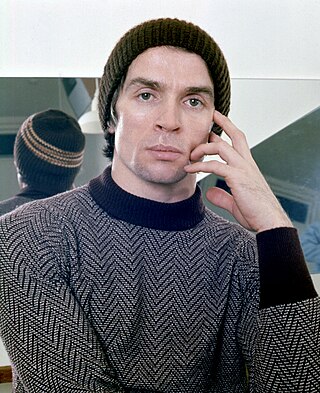
Rudolf Khametovich Nureyev was a Soviet-born ballet dancer and choreographer. Nureyev is widely regarded as the most preeminent male ballet dancer of his generation as well as one of the greatest ballet dancers of all time.

Art theft, sometimes called artnapping, is the stealing of paintings, sculptures, or other forms of visual art from galleries, museums or other public and private locations. Stolen art is often resold or used by criminals as collateral to secure loans. Only a small percentage of stolen art is recovered—an estimated 10%. Many nations operate police squads to investigate art theft and illegal trade in stolen art and antiquities.
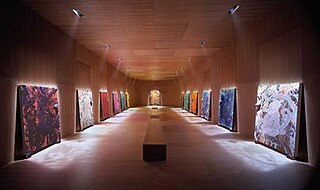
The Upper Room is an installation of 13 paintings of rhesus macaque monkeys by English artist Chris Ofili in a specially-designed room. It was bought by the Tate gallery in 2005 from the Victoria Miro Gallery and was the cause of a media furore after a campaign initiated by the Stuckist art group as Ofili was on the board of Tate trustees at the time of the purchase. In 2006 the Charity Commission censured the Tate for the purchase, but did not revoke it.

Three Studies for Figures at the Base of a Crucifixion is a 1944 triptych painted by the Irish-born British artist Francis Bacon. The canvasses are based on the Eumenides—or Furies—of Aeschylus's Oresteia, and depict three writhing anthropomorphic creatures set against a flat burnt orange background. It was executed in oil paint and pastel on Sundeala fibre board and completed within two weeks. The triptych summarises themes explored in Bacon's previous work, including his examination of Picasso's biomorphs and his interpretations of the Crucifixion and the Greek Furies. Bacon did not realise his original intention to paint a large crucifixion scene and place the figures at the foot of the cross.

The Stuckism International Gallery was the gallery of the Stuckist art movement. It was open from 2002 to 2005 in Shoreditch, and was run by Charles Thomson, the co-founder of Stuckism. It was launched by a procession carrying a coffin marked "The death of conceptual art" to the neighbouring White Cube gallery.
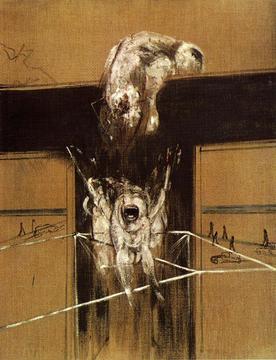
Fragment of a Crucifixion is an unfinished 1950 painting by the Irish-born figurative painter Francis Bacon. It shows two animals engaged in an existential struggle; the upper figure, which may be a dog or a cat, crouches over a chimera and is at the point of kill. It stoops on the horizontal beam of a T-shaped structure, which may signify Christ's cross. The painting contains thinly sketched passer-by figures, who appear as if oblivious to the central drama.

The Black Triptychs are a series of three triptychs painted by the British artist Francis Bacon between 1972 and 1974. Bacon admitted that they were created as an exorcism of his sense of loss following the suicide of his former lover and principal model, George Dyer. On the evening of 24 October 1971, two days before the opening of Bacon's career-making retrospective at the Grand Palais, Dyer, then 37, alcoholic, deeply insecure and suffering severe and long-term depression, committed suicide through an overdose of drink and barbiturates in a room at the Paris hotel Bacon had allowed him to share during a brief period of reconciliation following years of bitter recrimination.
Robert Dixon is a British mathematician and graphic artist, known primarily for his book Mathographics and for his plagiarism dispute with Damien Hirst. Dixon was a research associate at the Royal College of Art.

Portrait of George Dyer Talking is an oil painting on canvas executed in 1966 by the British painter Francis Bacon. It is a portrait of his lover George Dyer made at the height of Bacon's creative power. It depicts Dyer sitting on a revolving office stool in a luridly coloured room. His body and face are contorted, and his legs are tightly crossed. His head appears to be framed within a window or door. Above him is a naked hanging lightbulb, a favourite motif of Bacon's. The work contains a number of spatial ambiguities, not least that Dyer's body seems to be positioned both in the fore- and background.

Erica Brausen, was an art dealer and gallerist who established the Hanover Gallery in London in 1948. She was an early champion of several influential contemporary artists, most notably Francis Bacon.
Catharina "Toto" Koopman was a Dutch-Javanese model who worked in Paris prior to World War II. During that war she served as a spy for the Italian Resistance and was captured and held prisoner in the Ravensbrück concentration camp. She later helped establish the Hanover Gallery as one of the most influential art galleries in Europe in the 1950s.

José Capelo Blanco is a Spanish banker who was a friend of the British artist Francis Bacon. He was the subject of a 1987 portrait, Portrait of José Capelo and Triptych 1991. Capelo was given paintings and US$4 million by the artist, something Bacon would later confide he regretted doing, before his death in 1992.
Edward Michael Behrens was a British financier, banker, stockbroker, and restaurant and gallery owner, who became co-owner of the Ionian Bank. Through his ownership of the Hanover Gallery, he was an early patron of the artist Francis Bacon.
Tade Thompson FRSL is a British-born Nigerian psychiatrist and writer of Yoruba descent. He is best known for his 2016 science fiction novel Rosewater, which won a Nommo Award and an Arthur C. Clarke Award.

Study for Portrait II is a small 1955 oil-on-canvas painting by the Irish-born British figurative artist Francis Bacon, one of a series of six portraits completed after viewing that year the English poet, painter and printmaker William Blake's life mask at the National Portrait Gallery in London.
References
- 1 2 Hoge, Warren (23 March 1999). "Bacon Estate". New York Times. Retrieved 8 August 2021.
- 1 2 3 4 "Tate acquires Barry Joule Collection of material relating to Francis Bacon". Tate. 19 January 2004. Retrieved 8 August 2021.
- ↑ Alberge, Dalya (22 April 2018). "Right-hand man's £35m Francis Bacon boob" . The Sunday Times.
- 1 2 Alberge, Dalya (14 September 2019). "'I was the naked cricket model who posed for Francis Bacon'". The Observer. Retrieved 8 August 2021.
- 1 2 3 Alberge, Dalya (8 August 2021). "Tate donor warns: 'I'll take back my £20m Francis Bacon collection'". The Observer. Retrieved 8 August 2021.
- 1 2 Joule, Barry (18 September 2011). "Obituary: Rudolf Nureyev". The Independent . Retrieved 8 August 2021.
- 1 2 3 "Friend of Francis Bacon who he gave an £8m painting has claimed the BBC led thieves to steal artwork". T-Gate. 6 June 2021. Archived from the original on 8 August 2021. Retrieved 8 August 2021.
- ↑ "Strange World of Barry Who? (2004)". BFI. Archived from the original on 12 September 2017. Retrieved 8 August 2021.
- 1 2 Alberge, Dalya (6 June 2021). "Exclusive: Francis Bacon's friend claims BBC led to theft of his painting". The Telegraph– via www.telegraph.co.uk.
- ↑ "Francis Bacon: A Brush with Violence (2017)". BFI. Archived from the original on 11 May 2018. Retrieved 8 August 2021.